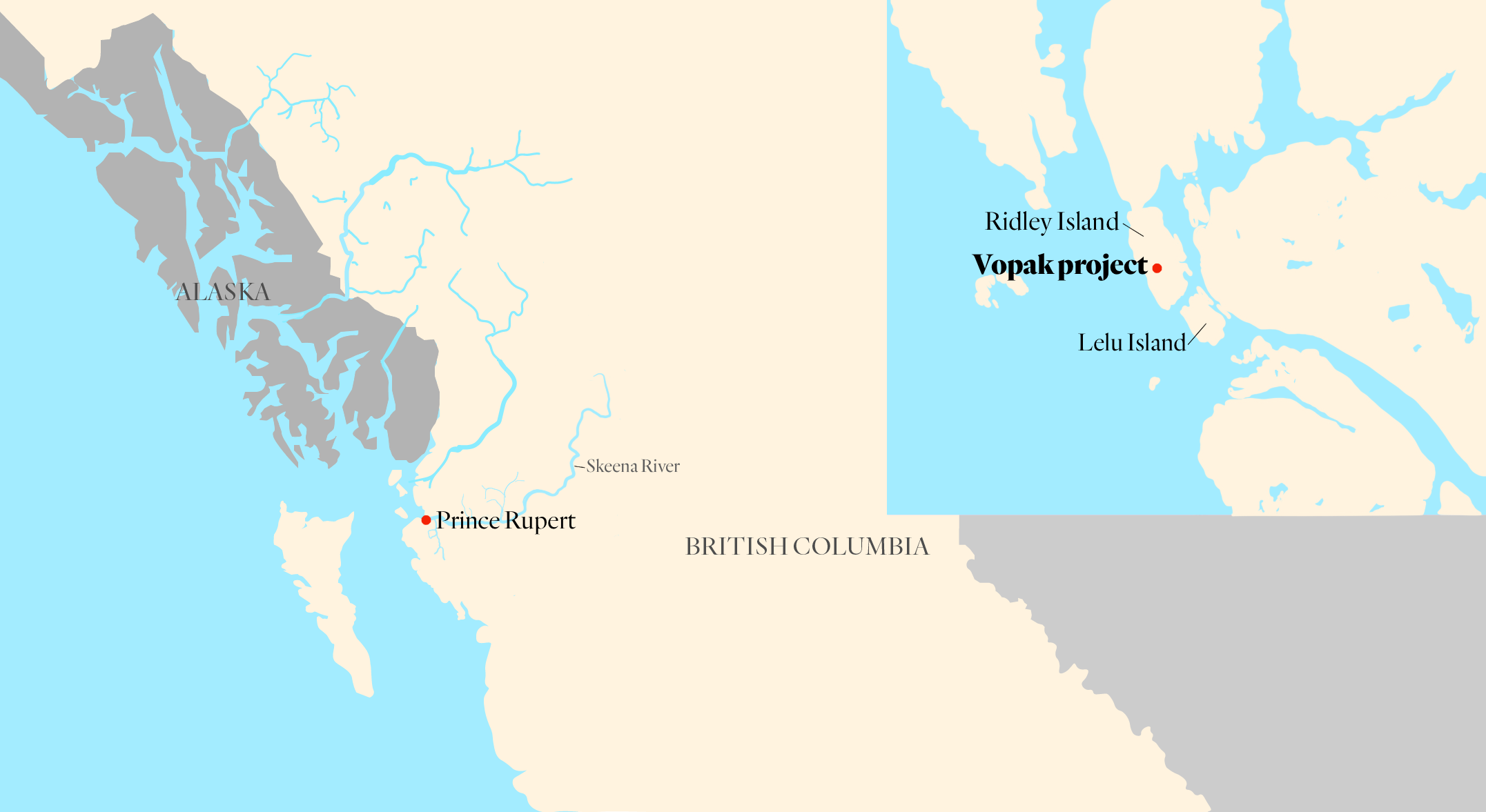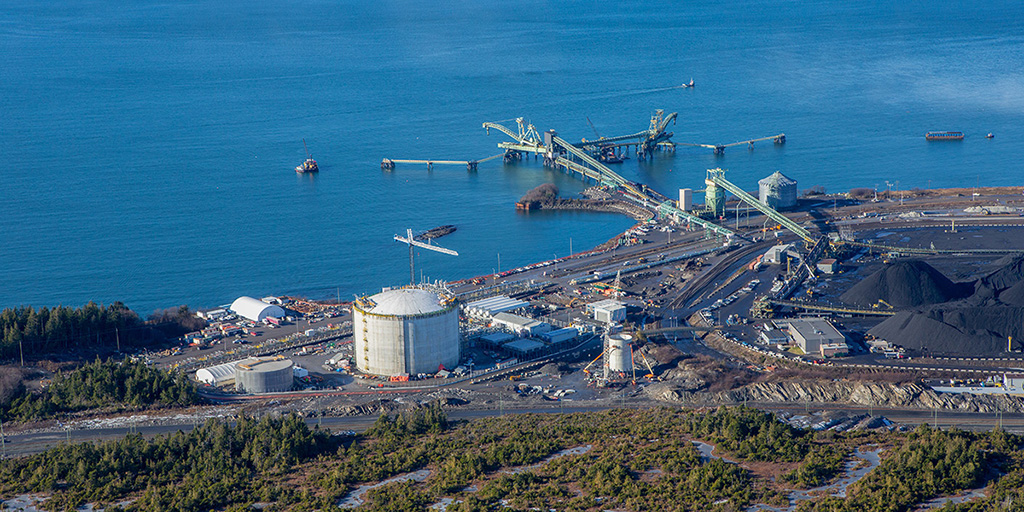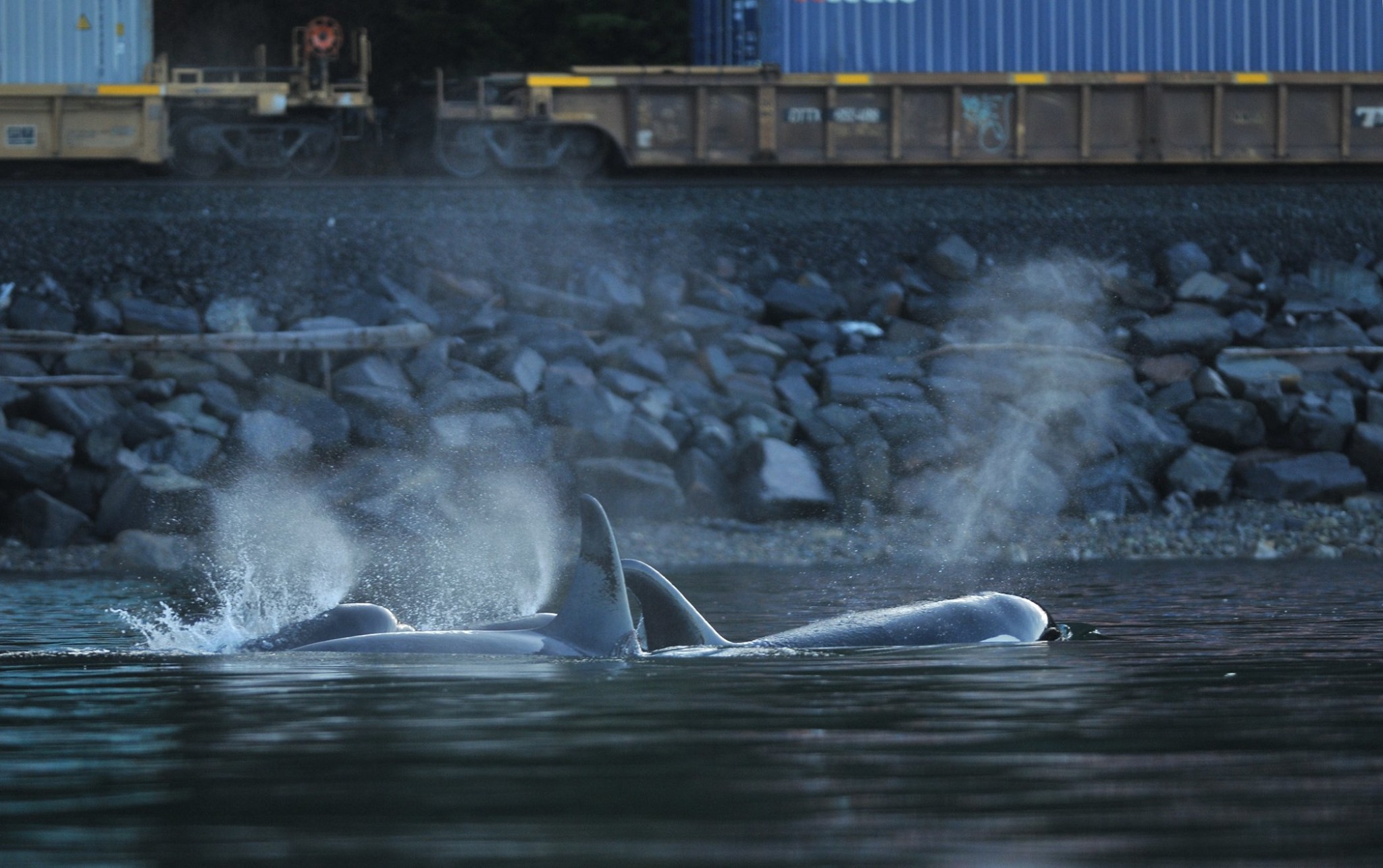
Hope for a huge, ancient and imperilled fish
First Nations are leading efforts to make sure lake sturgeon can find a home in...
Ridley Island in Prince Rupert, B.C., is home to the region’s primary export terminal. Freight trains rumble in 24/7, carrying goods like grain, coal and — more recently — liquefied petroleum gas, commonly known as propane. Massive ships in the adjacent deep waters are loaded with this cargo, mostly destined for transport across the Pacific.
All this noisy industriousness is a striking juxtaposition to the quiet ruggedness of the north coast landscape. A stone’s throw away is the thickly forested Lelu Island, which nearly became a liquefied natural gas export facility before Petronas abandoned the project in 2017. Flora Bank, an important habitat for juvenile salmon that’s protected by a development moratorium
, is just around the corner. And the Skeena River estuary is nearby, where innumerable marine species thrive. Increased industrial activity in the area puts all these important places at risk.
And if a new project gets the green light, Ridley Island is about to get a lot busier.
Vopak Development Canada is working on a plan to construct a bulk liquids terminal that would store propane, diesel, gasoline and methanol before it’s exported. Vopak is now working its way through B.C.’s environmental assessment process and hopes to be operating by 2022.
Here’s what you need to know about the proposed project.

A map showing the location of the Vopak Pacific Canada project on Ridley Island. Map: Carol Linnitt / The Narwhal
Vopak Development Canada is a subsidiary of Royal Dutch Vopak — the world’s largest independent oil storage company. Royal Dutch Vopak operates 66 terminals around the world, storing materials like liquefied natural gas, crude oil and various refined petrochemical products.
Vopak Canada already has a stake in Prince Rupert as a co-owner (with AltaGas) of Ridley Island Propane Export Terminal, the first propane export terminal in Canada. Its first shipment to Japan left Prince Rupert in May 2019. At full capacity, it can fill approximately 20 to 30 tankers per year. The proposed facility would be capable of shipping 150 tankers per year and would allow for additional types of refined fuels to be stored and shipped.
Vopak declined an interview request from The Narwhal and referred us to its website.

Vopak Canada has a 30 per cent stake in Canada’s first propane export facility, the Ridley Island Propane Export Terminal, and is hoping to expand that interest with the proposed Vopak Pacific Canada facility. Photo: Prince Rupert Port Authority
Vopak Pacific Canada would be a storage facility for companies selling their bulk liquid fuels to international markets.
Products such as propane, diesel, gasoline and methanol would be transported on the existing CN rail network from their sources in B.C. and Alberta to the storage facility. Propane — a fossil fuel primarily captured as a by-product of fracking LNG — would be pressurized for transport at its source. The companies shipping the fuels are responsible for them while they’re in transit.
At Vopak Pacific Canada, the rail cars would be unloaded and the fuels would be transferred to holding tanks. (Prior to being transferred, the propane would be cooled to -42 C.)
The facility would have a footprint of roughly 30 hectares. The land is currently forested and would be cleared for construction. Seen from above, the facility’s fuel storage tanks would look like giant Lego blocks. There would be a rail unloading system and cooling equipment. To facilitate export, the site would include a jetty and a berth — or a system of mooring buoys — suitable for very large oil tankers. These ships — contracted by Vopak’s clients — would be loaded over a 40-hour period.

An artist’s drawing of the proposed Vopak Pacific Canada facility. Photo: Vopak Canada
At this point, Vopak’s role would be complete, and the oil tankers would head out across the Pacific to sell the fuels to Japan, China and other countries. According to Vopak, methanol would be shipped to China, where it’s in high demand for use in manufacturing and as fuel additive, while propane would be shipped throughout Asia Pacific for heating and other industrial applications. Diesel and gasoline would be used for transportation.
On its website, Vopak says the project would take two years to complete, creating 200 jobs during that period. The company also says it would hire up to 50 people for permanent positions at the facility and provide skills training and jobs for local First Nations people.
Both provincial and federal environmental assessments are required for this project, but there’s a catch.
Ridley Island is owned by the federal government and a provision in the legislation allows for a project on federal land to undergo a significantly scaled back version of the federal environmental assessment depending on its size, scope and level of risk.
While a standard federal environmental assessment is a rigorous, multi-step process, this scaled-back version is essentially a planning process for the project.
Gavin Smith, a lawyer with West Coast Environmental Law, says even calling it an environmental assessment is generous. In 2018, West Coast Environmental Law asked the Impact Assessment Agency of Canada to designate the project for full federal assessment, but that request was denied.
The Prince Rupert Port Authority manages Ridley Island and is also managing the federal assessment, despite it having a vested interest in the project going ahead. Greg Knox, executive director of SkeenaWild Conservation Trust, says the fact that the port authority is running the federal assessment “is problematic given their conflict of interest.”
Ken Veldman, vice-president of public affairs and sustainability with the port authority, says the port is coordinating the assessment process with the B.C. Environmental Assessment Office. While the federal review is a separate process, the port uses the provincial assessment to consult with the public and Indigenous nations, he says. “The federal legislation isn’t as specific with regards to public consultation,” he adds.
As part of the B.C. environmental assessment, Vopak consulted with First Nations and held a public comment period in 2018.
Each of the six First Nations involved in the consultation process — Metlakatla, Lax Kw’alaams, Kitselas, Kitsumkalum, Gitxaala and Gitga’at — expressed concern about the increases in rail traffic, as did members of the public during the commenting period.
However, rail travel is not included in the provincial environmental assessment because the CN rail network is under the jurisdiction of Transport Canada.
According to an April 15 letter from the B.C. Environmental Assessment Office to Transport Canada, Vopak has committed to providing additional information regarding the potential effects of increased rail traffic to First Nations when it submits its application for an environmental assessment certificate.
Assessing potential marine risks is required as part of the provincial assessment.

Killer whales swim past a train on Ridley Island. Assessing Vopak Pacific Canada’s potential effects on the ocean is part of the provincial environmental assessment, but assessing the potential impacts of rail transportation is not. Photo: Caitlin Birdsall / Ocean Wise
The proposed project would see 240 rail cars travel through B.C. on the CN network every day, intersecting numerous communities and, for long sections, following the province’s largest rivers. Derailments are becoming more common, rising at a rate of about 10 per cent each year, according to the Transportation Safety Board of Canada.
While explosions are relatively rare, the increased rail traffic means increased risk, and the proximity of the CN line to northern communities puts the region’s population in harm’s way.
Earlier this year, a derailment near Prince George forced the closure of an elementary school. Seven of the cars that derailed were full of propane headed for Prince Rupert.
“Those kids are so lucky,” says Knox. “It’s astonishing that our communities don’t even know the risks.”
Those risks include potential impacts on fish, wildlife and vital habitat.
“We’ve had several derailments right into the Skeena,” he says.
If diesel in particular were to spill into the river, the impact on aquatic species would be deadly. “Diesel is one of the most highly toxic substances to fish,” Knox says.
In 2007, two CN trains carrying diesel and gasoline collided near Prince George and exploded, spilling fuel into the Fraser River. And in 2018, a train derailed near South Hazelton, spilling coal into Mission Creek.
“With CN’s increased rail traffic, there are huge risks our communities are exposed to,” says David DeWit, natural resources department manager for the Office of the Wet’suwet’en in Smithers.
Given the risks, he says a proposed increase in rail traffic of this size should be clearly communicated to all communities along the route, yet he had not heard of the Vopak project. He says CN has shown a lack of transparency that is frustrating to First Nations whose communities would be directly impacted by a derailment. “Something is amiss in all this.”
CN media representative Jonathan Abecassis explains that CN works directly with municipalities to keep communities informed about any dangerous goods travelling through their regions. “Rest assured, our emergency protocol has to be operational across the country.”
But Knox isn’t convinced. “I don’t have a lot of faith in CN,” he says. “They tend to pat you on the head and say, ‘Everything is OK.’ We need a better understanding of the risks.”
Prince Rupert has deep waters that can accommodate very large ships, but because its ocean floor is a thin layer of sediment on top of smooth rock, it’s unsuitable for anchorage. During a storm or hurricane — relatively common on the north coast — a ship can drag its anchor, potentially becoming grounded. If that happens, the ship’s hull can breach and its fuel and cargo spill.
“I think there is a definite potential for catastrophe,” says Luanne Roth of T. Buck Suzuki Environmental Foundation.
Given Vopak’s proximity to important habitats like Flora Bank, the effects of a spill would be felt across the entire Skeena watershed. Especially if it were diesel.

The proposed Vopak Pacific Canada facility is close to Lelu Island (forested island to the right), which nearly became an LNG export facility, and Flora Bank (bottom right), an important juvenile salmon habitat that’s protected by a development moratorium. Photo: Prince Rupert Port Authority / Facebook
“People think diesel just evaporates, but it doesn’t,” says Roth. Both she and Knox point to the Nathan E. Stewart, a tugboat and articulated barge that ran aground in Heiltsuk territory in 2016, spilling thousands of litres of diesel.
“They’re still dealing with that four years later,” says Knox.
If a significant spill — even just the fuel tanks of one of the large vessels — were to happen at or near Ridley Island, the impact would be severe.
In a report commissioned by T. Buck Suzuki Environmental Foundation, Chris Kennedy, an aquatic toxicologist at Simon Fraser University, looked into the effects of a spill if one of these supertankers were to become grounded near Ridley Island. “A spill of the magnitude suggested in this area will undoubtedly have extremely large biological impacts on the region, impacts which will affect the entire ecosystem and its components, possibly for decades; recovery to pre-oil spill conditions may never occur,” Kennedy concluded.
Roth has been investigating anchor dragging for years. Back in 2016, she did a study that found that Prince Rupert’s anchor-dragging incidents were 2,300 per cent higher than the Port of Vancouver’s — and they’re still increasing.
But she is optimistic. Her take is that the Vopak project presents an opportunity to solve this persistent problem, which would decrease the risks already facing Prince Rupert and its surrounding landscape. If the anchorage issue is addressed for this project, the same solution could be applied to all marine traffic in the region.
On June 21, 2019, the Oil Tanker Moratorium Act became law.
This act bans oil tankers from travelling in northern B.C. waters, protecting huge parts of the coastline. But, and this is the clincher, it only applies to crude oils. Vessels carrying refined oils like propane, methanol and diesel — such as the 150 takers the Vopak project would bring to Prince Rupert — are excluded from the moratorium.
Vopak is in the pre-application phase of the B.C. environmental assessment process, which means it’s preparing its draft application for an environmental assessment certificate.
According to Roth, Vopak’s draft environmental assessment certificate application should be submitted around early August. The federal part will also be submitted at this time. At this point, the public will be given another chance to comment on the proposed project. Once the draft application is revised, the company will submit its official application. The Environmental Assessment Office then reviews the application and conducts an assessment of the effects on the environment, at which point the public gets one last chance to comment.
After the public comment period is closed, the Environmental Assessment Office takes those comments into consideration and consults with the provincial government, the six First Nations, Fisheries and Oceans Canada, Transport Canada and several other stakeholders to identify any risks still associated with moving forward. All of these stakeholders have to sign off on the project.
If everything checks out and all involved agree: green light.
Update June 27, 2020 at 11:05 a.m. PST: This article was updated to clarify that the Vopak project could service 150 tankers carrying liquid gas and not oil as previously stated in the story’s deck head. A separate update was made to clarify the relationship between Ridley Terminals and the Vopak project. The company is not “working with” Vopak on the latter’s project proposal as the story previously incorrectly stated.
Update June 30, 2020 2:11 p.m. PST: This article was updated to remove reference to Ridley Terminals, a private coal and petroleum coke export terminal on Ridley Island. A previous version of this article incorrectly stated that Ridley Terminals managed all the unloading, product storage and vessel loading operations on the island.
Get the inside scoop on The Narwhal’s environment and climate reporting by signing up for our free newsletter. Angello Johnson’s shoulders burn, and his arms...
Continue reading
First Nations are leading efforts to make sure lake sturgeon can find a home in...

We’re excited to share that an investigation by The Narwhal is a finalist for the...

A new documentary, Nechako: It Will Be a Big River Again, dives into how two...
